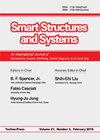Damped forced vibration analysis of layered functionally graded thick beams with porosity
IF 2.2
3区 工程技术
Q2 ENGINEERING, CIVIL
引用次数: 2
Abstract
The following article presents the damped forced vibration of layered functionally graded thick beams including material porosities. In case of very thick beams, beam theories fail to satisfy boundary conditions and to predict the mechanical response accurately. So, the two-dimensional (2D) plane continuum model is exploited to model a thick functionally graded layered beam. The beam is composed from three- layers with functionally graded porous materials. The porosity is described by three different distribution models through the layer thickness. Applied forces to the functionally graded beam are assumed to be sinusoidal harmonic point load in time domain. The KelvinVoigt viscoelastic constitutive model is used to simulate damping effect. The governing equations are obtained by using Lagrange's equations. In frame of finite element analysis, twelve .node 2D plane element is exploited to discretize the space domain of thick beam. In the solution of the dynamic problem, the Newmark average acceleration method is used. Numerical studies illustrate effects of porosity distribution, stacking sequence, and graduation constant on the dynamic responses of layered functionally graded porous thick beams. The results show that the porosity function, stacking sequences and the damping ratio have a vital role in dynamic response of functionally graded beams. The proposed model can be used in nuclear, marine, and aerospace technologies.具有孔隙的分层功能梯度厚梁的阻尼强迫振动分析
以下文章介绍了包括材料孔隙率在内的分层功能梯度厚梁的阻尼强迫振动。在非常厚的梁的情况下,梁理论不能满足边界条件,也不能准确地预测力学响应。因此,利用二维(2D)平面连续体模型对厚功能梯度层状梁进行建模。梁由三层功能梯度多孔材料组成。孔隙率通过三种不同的层厚度分布模型来描述。假设作用在功能梯度梁上的力是时域中的正弦谐波点载荷。采用Kelvin-Voigt粘弹性本构模型模拟阻尼效应。利用拉格朗日方程得到了控制方程。在有限元分析框架中,采用十二节点二维平面单元对厚梁的空间域进行离散。在求解动力学问题时,使用了Newmark平均加速度法。数值研究表明,孔隙率分布、堆积顺序和分级常数对层状功能梯度多孔厚梁动力响应的影响。结果表明,孔隙率函数、叠层顺序和阻尼比对功能梯度梁的动力响应起着至关重要的作用。所提出的模型可用于核、海洋和航空航天技术。
本文章由计算机程序翻译,如有差异,请以英文原文为准。
求助全文
约1分钟内获得全文
求助全文
来源期刊

Smart Structures and Systems
工程技术-工程:机械
CiteScore
6.50
自引率
8.60%
发文量
0
审稿时长
9 months
期刊介绍:
An International Journal of Mechatronics, Sensors, Monitoring, Control, Diagnosis, and Management airns at providing a major publication channel for researchers in the general area of smart structures and systems. Typical subjects considered by the journal include:
Sensors/Actuators(Materials/devices/ informatics/networking)
Structural Health Monitoring and Control
Diagnosis/Prognosis
Life Cycle Engineering(planning/design/ maintenance/renewal)
and related areas.
 求助内容:
求助内容: 应助结果提醒方式:
应助结果提醒方式:


